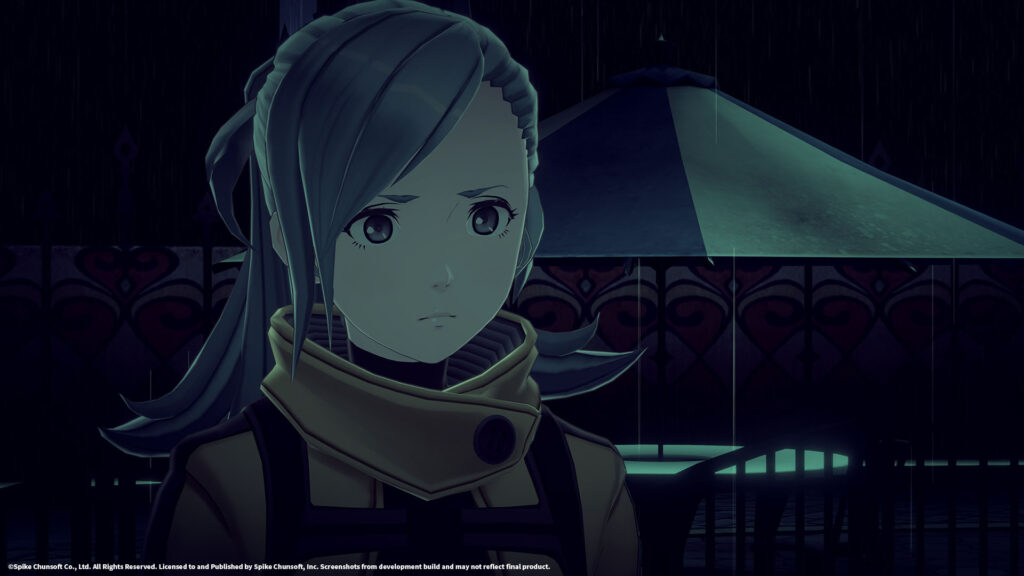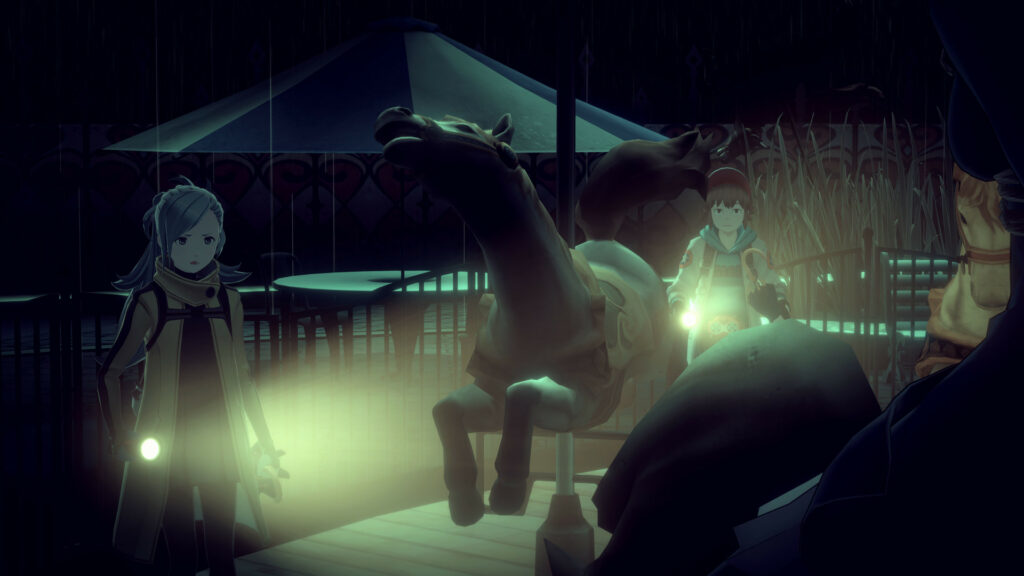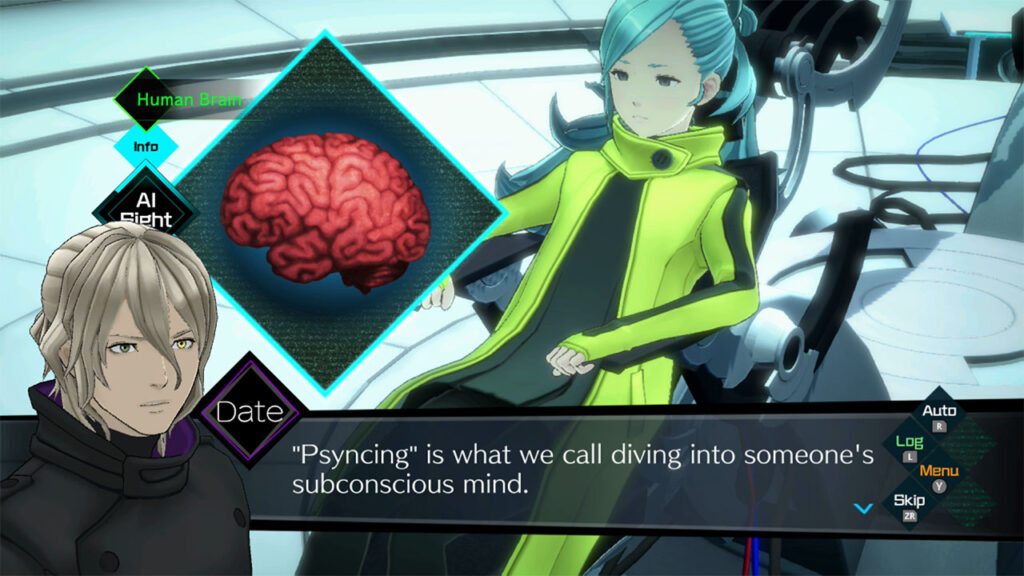AI: The Somnium Files – a masterful murder mystery
You know how sometimes you pick up a game that you know you will enjoy, and that everyone around you whose opinion you trust says you will enjoy, and yet you somehow still sit on it for several years before actually getting around to playing it? That’s me with AI: The Somnium Files.
I didn’t put off playing it for any particular reason other than the fact that I was playing other things at the time. But now I have played it. And it is indeed a wonderful thing.

To provide some context as to why I’m talking about this right now, after greatly enjoying World’s End Club — another title which I’d held off on playing for far too long — I figured it was time I revisited some of gaming auteur Kotaro Uchikoshi’s other titles.
I was already familiar with the Nintendo DS original version of Nine Hours, Nine Persons, Nine Doors (which I still have to look up the title of every time I write about it just to make sure I got them in the right order) and its follow-up Virtue’s Last Reward on Vita and 3DS, and I had enjoyed both of those games a great deal. And so it should have been a given that I would enjoy AI: The Somnium Files. And, indeed, I most certainly did enjoy it. So let’s talk about that, with minimal spoilers for the benefit of anyone else who has been sitting on this fantastic murder mystery for far too long.
AI: The Somnium Files is a Japanese-style adventure game that features lengthy visual novel-style story sequences, but also plenty of interactivity. You’ll investigate locations from a first-person point-and-click interface, and also have to solve certain puzzle sequences by controlling a character from a third-person perspective and making decisions against the clock.
If visual novels aren’t normally your jam, AI: The Somnium Files is still worth a look, as the amount of interactivity it features means that it’s a good, gentle introduction to the medium. There’s enough “game” here to keep it feeling like you’re playing something rather than simply reading what is unfolding, and a sense that you’re solving the game piece by piece rather than everything just neatly resolving in front of you.

AI: The Somnium Files casts players in the role of Kaname Date, a detective with the Tokyo Metropolitan Police who works for the secret ABIS division. ABIS’ jam is peeking into people’s brains using their Psync machine, which allows suitably trained agents to delve into the dreams of witnesses and suspects, wander around within them and even interact with them in order to uncover truths hidden behind “Mental Locks”.
As the story opens, a murder has taken place. A woman named Shoko has been killed, and her body displayed on a merry-go-round in a disused public park in a region of Tokyo that had been quarantined after a chemical explosion. Her eye had been forcibly removed, and a 12 year old girl named Mizuki, whom Date is the de facto guardian of at the request of her separated parents, appears to be a prime suspect.
Mizuki was found concealed in the central column of the merry-go-round, clutching a bloodstained icepick that had clearly been used at the very least to remove Shoko’s eye, and possibly also to commit the murder — but a bit of investigation reveals that the murder seemed to have occurred elsewhere. From here, an investigation begins, with Date hot on the trail of a killer whom press and public alike start referring to as “The New Cyclops Serial Killer”.
An interesting thing about AI: The Somnium Files is that the entire 40-hour duration of the game encompasses this single case. This is relatively unusual to see in detective-style games, which tend to incorporate multiple cases in order to break things up somewhat — see Capcom’s Ace Attorney series for a good example. But no; here, we have a complicated case with a number of layers to it — and the various routes down which the story can proceed mean that the investigation can unfold quite differently according to your actions!

Structurally, AI: The Somnium Files is a bit simpler than the Zero Escape games — particularly the labyrinthine Virtue’s Last Reward — in that the points where the routes split are always made extremely obvious. There are also only a couple of sequences where you’re locked off from seeing the conclusion of a particular route until you’ve seen another one, as opposed to the myriad blocked routes you’d encounter in VLR. This is perhaps a shame for those hoping to see Uchikoshi at his most obtuse, but it’s clear that the emphasis on here is very much on telling the various stories in each route rather than trying to be self-consciously “clever”.
Indeed, AI: The Somnium Files itself doesn’t make any real effort to explain how and why the different routes exist. There are the odd implications that we might be looking at different timelines or parallel universes, but these suggestions are often put forward by characters who aren’t exactly authorities on the subject, to say the least.
As such, certain things are left up to the player’s own interpretation — though it does become clear towards the end of the narrative that at least some connections between the different routes are intentional. Follow-up AI: The Somnium Files – Nirvana Initiative explores this concept a little more, but that’s a discussion for another day — largely ’cause I haven’t finished it at the time of writing.

Anyway, the split points in AI: The Somnium Files occur not during the investigation sequences in the “real world”, but rather in the “Somnium” sequences where Date makes use of the Psync machine to explore the dream worlds of various witnesses and suspects in the game — beginning with the aforementioned Mizuki. The narrative splits tend to occur when there are rather drastic binary choices to make during the Somnium sequences — indeed, the very first one determines whether Mizuki feels able to speak about her experiences after waking up, or remains traumatised by them for a considerable portion of the main narrative.
These Somnium sequences are arguably where the majority of what can be called “gameplay” in AI: The Somnium Files lies. Taking command of the AI known as Aiba who lives in Date’s left eyeball, you explore each character’s dream world, interacting with objects that make themselves obvious to you. The twist is that you only have a total of 360 seconds to spend during any trip into Somnium — for reasons that are explained much later in the story — and taking various actions costs varying amounts of time.
There are a few features that will help you out during these sequences, though. Firstly, time slows down to a crawl when Aiba isn’t moving, which means that she (and you) can look around and survey the environment without too much pressure, so long as you’re not actively walking around or attempting to interact with things.
Secondly, taking certain actions rewards you with “Timies” that can be used to manipulate the amount of time various actions take. For the most part, this involves reducing the amount of time something takes either by a fraction or a specified amount of time, though in some cases you can encounter “negative Timies” that you have to use, all of which increase the time something takes in various ways.

The early Somnium sequences are relatively straightforward when it comes to the time limit, but as you approach the end point of the various routes, the puzzles become as much about manipulating the time limit as they are about figuring out what the right action to take is. On multiple occasions, you’ll need to deliberately take “wrong” actions just to collect Timies, then make use of these Timies on the particularly long-winded actions in order to succeed. It provides a fun twist on the core puzzling without ever becoming too brain-frying; don’t expect anything as obtuse as some of Zero Escape’s more notorious room escape sequences here.
At heart, the Somnium sequences are an opportunity to explore various characters from different perspectives. And, by extension, the core appeal of AI: The Somnium Files, much like we talked about with World’s End Club, is the wonderfully varied and incredibly memorable cast of characters.
In contrast to some of Uchikoshi’s other works, where the main character is kept deliberately relatively “plain” in order to help the player project themselves into the experience, in AI: The Somnium Files Date is very much his own character that we happen to be riding along with. In many respects, we’re in a similar position to Aiba in that we can see through his eyes and influence his actions, but not necessarily take direct control of him. He’s his own person with his own thoughts, feelings and opinions — and he’s endearingly fallible, particularly when it comes to anything even vaguely related to erotic material.
His “buddy cop” relationship with Aiba is also an absolute highlight of the experience. Since Aiba is inevitably present wherever Date is, we often get to hear her own thoughts on the situation — as well as her own takes on the things that Date is thinking. The pair of them clash quite a bit in terms of values and personality — but it’s also clear that they respect one another and care deeply about each other. There’s one sequence towards the end of the game’s “true” ending where this is especially apparent — but I shall save the details of that for you to discover.

Aiba is a particularly fascinating character in that her personality seems to work on many levels. While she’s safely nestled in Date’s eyeball — or indeed popping out of it to make use of her limited “real world” body — she’s intelligent, calm and rational, often the perfect foil to Date’s tendency to react somewhat emotionally. Whenever she’s “set free” during a Somnium sequence, however, we see her obviously feeling like she wants to let loose in various ways — be that through silly dances, mimicking things she’s seen in other media or simply cracking jokes.
AI: The Somnium Files attributes this to only a fraction of Aiba’s processing power being transferred through the Psync process, leaving her reliant on Date to tell her what to do if they want to actually accomplish anything useful, but one suspects that Aiba always relishes the opportunity to be a bit silly and have a convenient excuse ready to “explain” it. Plus Date always seems to appreciate these moments of levity, also, which only makes the relationship between the pair of them more enjoyable to watch develop over the course of the game.
Another highlight of the story as a whole is the aforementioned Mizuki, who plays a major role in the narrative as a whole, regardless of which route you find yourself proceeding down. Although just twelve years old, she is wise beyond her years — more so than Date in many respects — and also inexplicably blessed with seemingly superhuman strength. (Nirvana Initiative does also address this, but again, we’ll talk about that another time.)
Mizuki is an incredibly interesting, likeable character because despite her physical capabilities being notably abnormal, in many respects she is one of the most straightforward, relatable members of the cast. She has a realistically troubled but affectionate relationship with Date, and the exploration of her relationship with her parents seen in “her” route through the story is heartbreaking to watch — but also inspiring when you see her emerge from the other side in possession of as much personal and emotional strength as she has.

Elsewhere, the narrative tackles a variety of themes through the character Iris, also known as Internet idol A-Set. Iris tends to play a key role in pretty much every route through the story, though the reasons why she takes centre stage change quite considerably from one path to another. In some routes she is seen as commentary on online stardom and the lengths that fans will go in pursuit of their favourite performers; in another, she explores the possibility of the game’s happenings being connected to conspiracy theories and other strange phenomena; in the “true” route, her role is rather more sober — though again, we’ll refrain from sharing the details for now.
Iris is in quite an interesting position in that most visual novels would probably try to position her as a love interest — though outside of a couple of sequences where the 36-year old Date has rather impure and unrealistic thoughts about the 18-year old Iris, she is instead mostly kept at arms’ length as a character whom most of the rest of the cast have a warm, platonic friendship with.
This also goes for her biggest fan Ota, who we’re led to believe is 24 years old, but who is deliberately designed to come across as rather childish. Ota remains something of a mystery for quite a bit of the narrative, as it’s clear he has quite a few of his own things going on — and his obsession with Iris, or rather “A-Set” is distraction from those things — but he’s also an intriguing character in his own right. Indeed, the narrative that explores his relationship with his mother is emotionally engaging, touching and rather down-to-earth compared to some of the other stuff that goes on throughout AI: The Somnium Files.
This is one of the most effective things about AI: The Somnium Files’ multi-route structure. While ostensibly each of the routes involve Date and Aiba investigating the New Cyclops Serial Killer, the focus in each becomes very different by their midpoint, and indeed in many routes the case remains unsolved by the time you roll credits, implying that the personal stories explored are of greater importance than the “big plot”.

This is good, because it means we get the opportunity to spend time with a fascinating, incredibly likeable ensemble cast in a variety of different contexts, all within the space of a single game. It allows us to see different sides of these characters and determine if they act differently when they’re under intense pressure or in immediate danger to when they’re just attempting to go about their daily business. And it shows that even when there’s something that seems to be super-important to you, sometimes others are going through their own troubles and strife that only they can truly understand the magnitude of.
I could happily talk for hours about AI: The Somnium Files and the many strange and wonderful things that happen over the course of its various narrative routes. But I feel my own experience with the game was helped enormously by the fact that I didn’t really know what to expect going in to it, other than an awareness that a lot of people I know and trust really enjoyed it.
So I’m going to leave that there, spoiler-free, for now and just say that AI: The Somnium Files is one of the most enjoyable murder mysteries I’ve ever had the good fortune to enjoy on home gaming systems — and I encourage you to give it a go for yourself if you, like me, have been putting it off for the last few years!
AI: The Somnium Files is available now for PC via Steam, PlayStation 4 (physical and digital) and Nintendo Switch (physical and digital).
Join The Discussion
Rice Digital Discord
Rice Digital Twitter
Rice Digital Facebook
Or write us a letter for the Rice Digital Friday Letters Page by clicking here!
Disclosure: Some links in this article may be affiliate links, which means we may earn a small commission if you make a purchase after clicking on them. This is at no additional cost to you and helps support Rice Digital!
- Letter from the Editor: passing the torch - June 30, 2023
- Super Woden GP 2 is looking promising - June 30, 2023
- Inti Creates is making a 32 bit-style Love Live action platformer - June 26, 2023







